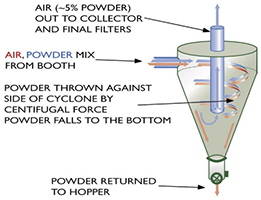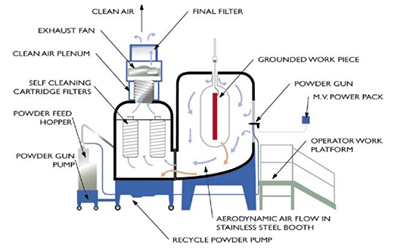Powder Coating Troubleshooting Guide
Chapter Eight: Powder Coating Recovery Equipment
General Design Principles
Powder coatings are efficient in their use partly due to the ability to recover and reuse the excess overspray from the coating booths. The recovery system consists of three components: the booth which contains the excess powder, the collector which retrieves the excess, and the filters which clean and return the air.
Booth:
- Allows for a contained area for the application and containment of excess powder
- Provides a controlled atmosphere with safe operating levels of powder cloud density
- Permits the maximum possible exposure time of the parts to the powder cloud
- Optimize the powders cloud concentration towards the parts and away from the booth walls
Collector:
- Separates the powder from the air stream exhaust
- Allows for a maximum retrieval rate of oversprayed powder
- Permits a central collection area to reintroduce reclaim powder into the virgin powder
Filter:
- Allows for the return of cleaned conditioned air, either heated or cooled, back into the coating area
Conventional Recovery System (Cyclonic)

Cartridge Recovery System

|
Daily Booth Maintenance
|
Color Change Considerations
|
Other Chapters
- Early Powder Coatings, Uses, and Types
- Manufacturing of Powder Coatings
- Powder Chemistries, Formulations, Comparisons, and Uses
- Comparisons to Liquid Coatings
- Measuring Up the Product
- Pretreatment
- Powder Application Methods and Equipment
- The Electrostatic Charge Process
- Powder Application Tips
- Powder Curing Process
- Safety Issues With Powder Coatings
- TCI Troubleshooting Guide
- Glossary of Industry Related Terms
